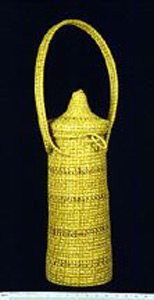Purse or Sewing Basket
1975.13.0002
Detailed Images
Basic Information
| Artifact Identification | Purse or Sewing Basket (1975.13.0002) |
|---|---|
| Classification/ Nomenclature |
|
| Artist/Maker | Harriet Barnwell |
| Geographic Location | |
| Period | N/A |
| Date | 1975 CE |
| Culture | Afro - American |
| Location | Not on Exhibit |
Physical Analysis
| Dimension 1 (Height) | 69.0 cm |
|---|---|
| Dimension 2 (Width) | 27.5 cm |
| Dimension 3 (Depth) | 20.0 cm |
| Weight | 1040 g |
| Measuring Remarks | N/A |
| Materials | Plant |
| Manufacturing Processes | N/A |
Research Remarks
| Description | N/A |
|---|---|
| Published Description | Under Review |
| Bibliography | Derby, Doris A., Black Women Basket Makers: A Study of Domestic Economy in Charleston County, South Carolina, May 1980. |
Artifact History
| Credit Line/Dedication | Purchase |
|---|---|
| Reproduction | No |
Contact
All information about our collection is constantly reviewed and updated. Please contact Dery Martínez-Bonilla, Registrar, if there is any information you are looking for that isn't currently online.
